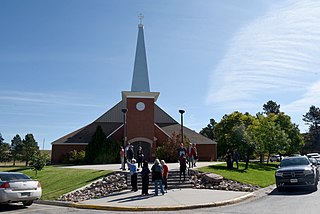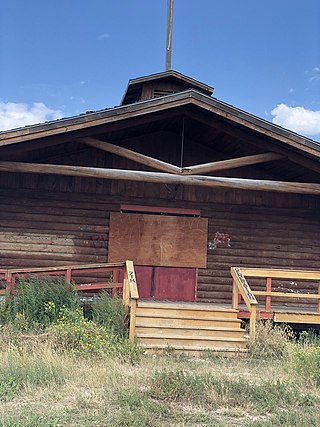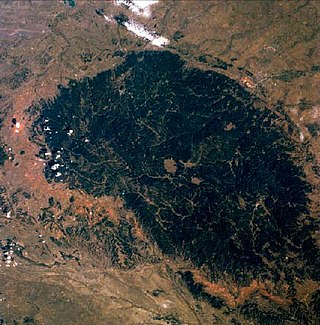JoAnn Tall | |
|---|---|
| Nationality | American |
| Known for | Anti nuclear activism |
| Awards | Goldman Environmental Prize |
JoAnn Tall is an environmental activist of the Oglala Lakota tribe who has worked to ensure the people have a chance to approve major projects for energy development. She was awarded the Goldman Environmental Prize in 1993 for her protests against uranium mining and plans for testing nuclear weapons in the Black Hills area, near the Pine Ridge Indian Reservation where she lives. [1]
Tall was involved with the Black Hills Alliance in the 1970s, [2] a group consisting of locals and environmentalists who investigated and tracked the records of uranium companies looking to mine in the region. [3] The activists worked to ensure that any energy development projects proposed for the region would need to be approved by the voters rather than being automatically approved by the State. [4]
Tall is an original board member for KILI, the local radio station for Pine Ridge Reservation. In August 1992, the station was protested for several months by local Oglala Lakota tribe members who believed that their freedom of speech and traditions were being suppressed by the white manager of the station. [5]
In 1989 Tall co-founded the Native Resource Coalition in order to help educate the Lakota regarding health and environmental issues. [1]
Tall and her husband Mark Tilsen [6] have eight children. [1]

The Lakota are a Native American people. Also known as the Teton Sioux, they are one of the three prominent subcultures of the Sioux people. Their current lands are in North and South Dakota. They speak Lakȟótiyapi—the Lakota language, the westernmost of three closely related languages that belong to the Siouan language family.

The Sioux or Oceti Sakowin are groups of Native American tribes and First Nations peoples in North America. The modern Sioux consist of two major divisions based on language divisions: the Dakota and Lakota; collectively they are known as the Očhéthi Šakówiŋ. The term "Sioux" is an exonym created from a French transcription of the Ojibwe term "Nadouessioux", and can refer to any ethnic group within the Great Sioux Nation or to any of the nation's many language dialects.

Pine Ridge is a census-designated place (CDP) and the most populous community in Oglala Lakota County, South Dakota, United States. The population was 3,138 at the 2020 census. It is the tribal headquarters of the Oglala Sioux Tribe on the Pine Ridge Indian Reservation.

Porcupine is a census-designated place (CDP) in Oglala Lakota County, South Dakota, United States. The population was 925 at the 2020 census.

The American Indian Movement (AIM) is a Native American grassroots movement which was founded in Minneapolis, Minnesota in July 1968, initially centered in urban areas in order to address systemic issues of poverty, discrimination, and police brutality against Native Americans. AIM soon widened its focus from urban issues to many Indigenous Tribal issues that Native American groups have faced due to settler colonialism in the Americas. These issues have included treaty rights, high rates of unemployment, Native American education, cultural continuity, and the preservation of Indigenous cultures.

Red Cloud was a leader of the Oglala Lakota from 1868 to 1909. He was one of the most capable Native American opponents whom the United States Army faced in the western territories. He defeated the United States during Red Cloud's War, which was a fight over control of the Powder River Country in northeastern Wyoming and southern Montana. The largest action of the war was the Fetterman Fight, with 81 US soldiers killed; it was the worst military defeat suffered by the US Army on the Great Plains until the Battle of the Little Bighorn 10 years later.

The Pine Ridge Indian Reservation, also called Pine Ridge Agency, is an Oglala Lakota Indian reservation located almost entirely within the U.S. state of South Dakota, with a small portion in Nebraska. Originally included within the territory of the Great Sioux Reservation, Pine Ridge was created by the Act of March 2, 1889, 25 Stat. 888. in the southwest corner of South Dakota on the Nebraska border. Today it consists of 3,468.85 sq mi (8,984 km2) of land area and is one of the largest reservations in the United States.

Whiteclay is an unincorporated community and census-designated place in Sheridan County, Nebraska, United States. The population was 10 at the 2010 census.

Russell Charles Means was an Oglala Lakota activist for the rights of Native Americans, libertarian political activist, actor, musician and writer. He became a prominent member of the American Indian Movement (AIM) after joining the organization in 1968 and helped organize notable events that attracted national and international media coverage.

The Great Sioux Reservation initially set aside land west of the Missouri River in South Dakota and Nebraska for the use of the Lakota Sioux, who had dominated this territory. The reservation was established in the Fort Laramie Treaty of 1868. It included all of present-day western South Dakota and modern Boyd County, Nebraska. This area was established by the United States as a reservation for the Teton Sioux, also known as the Lakota: the seven western bands of the "Seven Council Fires".
Cecilia Fire Thunder is a nurse, community health planner and tribal leader of the Oglala Sioux. On November 2, 2004, she was the first woman elected as president of the Tribe. She served until being impeached on June 29, 2006, several months short of the two-year term. The major controversy was over her effort to build a Planned Parenthood clinic on the reservation after the South Dakota legislature banned most abortions throughout the state. The tribal council impeached her for proceeding without gaining their consensus.

The Wounded Knee Occupation, also known as Second Wounded Knee, began on February 27, 1973, when approximately 200 Oglala Lakota and followers of the American Indian Movement (AIM) seized and occupied the town of Wounded Knee, South Dakota, United States, on the Pine Ridge Indian Reservation. The protest followed the failure of an effort of the Oglala Sioux Civil Rights Organization (OSCRO) to use impeachment to remove tribal president Richard Wilson, whom they accused of corruption and abuse of opponents. Additionally, protesters criticized the United States government's failure to fulfill treaties with Native American people and demanded the reopening of treaty negotiations to hopefully arrive at fair and equitable treatment of Native Americans.
Richard A. Wilson was elected chairman of the Oglala Lakota of the Pine Ridge Indian Reservation in South Dakota, where he served from 1972–1976, following re-election in 1974.

The Oglala are one of the seven subtribes of the Lakota people who, along with the Dakota, make up the Očhéthi Šakówiŋ. A majority of the Oglala live on the Pine Ridge Indian Reservation in South Dakota, the eighth-largest Native American reservation in the United States.

KILI, licensed to Porcupine, South Dakota, is a non-profit radio station broadcasting to the Lakota people on the Pine Ridge, Cheyenne River, and Rosebud Indian Reservations, part of the Great Sioux Nation. The station started broadcasting in 1983 as the first American Indian-owned radio station in the United States.

The Black Hills land claim is an ongoing land dispute between Native Americans from the Sioux Nation and the United States government over the Black Hills mountain range in the US states of South Dakota and Wyoming. The land in question was pledged to the Sioux Nation in the Fort Laramie Treaty of April 29, 1868, but a few years later illegally seized and the treaty nullified in the Indian Appropriations Bill of 1876 without the tribe's consent. That bill "denied the Sioux all further appropriation and treaty-guaranteed annuities" until they gave up the Black Hills. A Supreme Court case was ruled in favor of the Sioux in 1980. The Sioux have outstanding issues with the ruling and have not collected the funds. As of 2011, the award was worth over $1 billion.
Lorelei DeCora Means, born Lorelei De Cora, was a Native American nurse and civil rights activist. She is best known for her role in the second siege in the town of Wounded Knee, South Dakota, on the Pine Ridge Indian Reservation. She was also a co-founder of the American Indian organization, Women of All Red Nations.
Manypenny Agreement is a United States Congressional act passed on February 28, 1877, it officially removed ownership of the Black Hills from the Lakota Sioux and the United States took control of 900,000 acres of the Black Hills.
Debra White Plume was a Lakota political activist and water protector. She fought to protect the traditional Oglala Lakota way of life.
Bryan V. Brewer was president of the Oglala Sioux Tribe from 2012 to 2014.